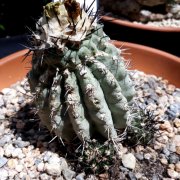Care of the cactus Copiapoa calderana or Copiapoa lembckei |
|
The genus Copiapoa, family Cactaceae, comprises 25 species of cactus native to northern Chile. Some species are: Copiapoa calderana, Copiapoa grandiflora, Copiapoa cinerea, Copiapoa malletiana, Copiapoa gigantea, Copiapoa humilis, Copiapoa coquimbana, Copiapoa taltalensis, Copiapoa echinoides, Copiapoa krainziana, Copiapoa marginata. This species is native to Chile. Scientific synonyms: Copiapoa atacamensis, Copiapoa lembckei. They are solitary cacti (sometimes producing suckers) with a light green globose or cylindrical body that reach 10 cm (3.93") in diameter. They have 10 to 17 rounded ribs with gray areolas that turn white. They have 4-7 radial spines and 1-2 central brown spines that turn grayish. They produce scented yellow flowers at the apex of the cactus. These slow-growing plants are used in rockery, in cold greenhouses and on balconies, terraces, and in well-ventilated and well-lit interiors. Copiapoa calderana needs full sun exposure and temperatures above 4 ºC (39.2 ºF). It does not resist frost. The soil can be a commercial cactus substrate with 20% coarse siliceous sand. The transplant is done in early spring. Water moderately, waiting for the substrate to dry completely; they are sensitive to excess moisture. In winter the waterings are suspended. Fertilize every 3 weeks in summer with mineral fertilizer for cacti rich in potassium. Copiapoa atacamensis does not need pruning. Copiapoa calderana is a plant sensitive to excess humidity; it can be attacked by mites and mealybugs if ventilation is not adequate. Copiapoa lembckei propagates by seeds sown in a nursery without direct sun; it does not always produce suckers. |
Images of the cactus Copiapoa calderana or Copiapoa lembckei |
Find plants
Copiapoa calderana or Copiapoa lembckei | Care and Growing
© 2026 FavThemes



